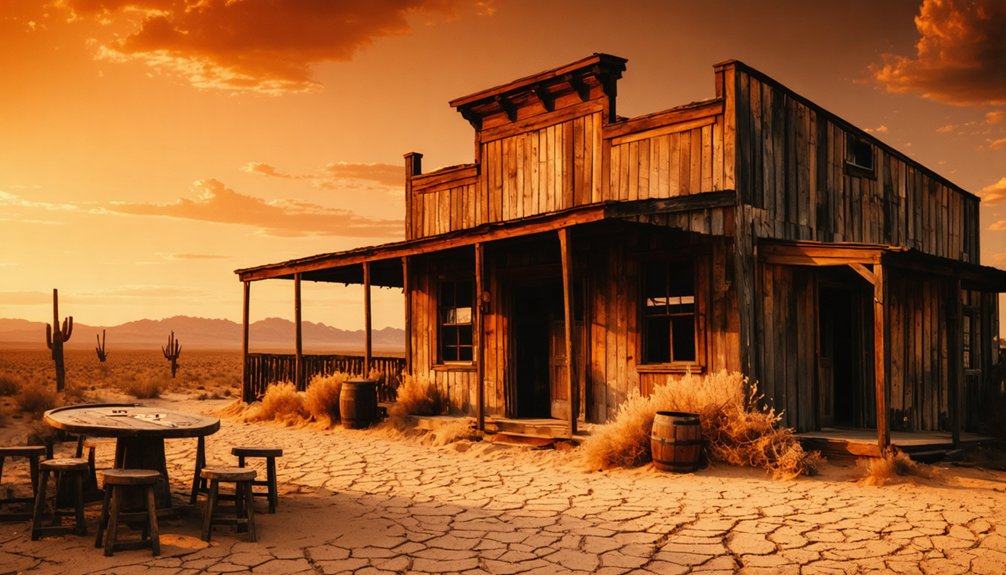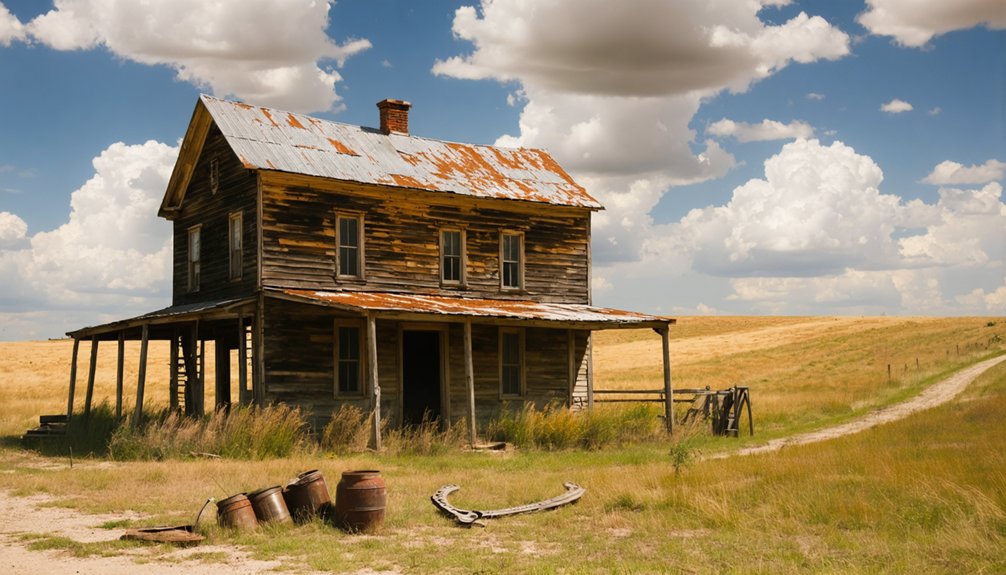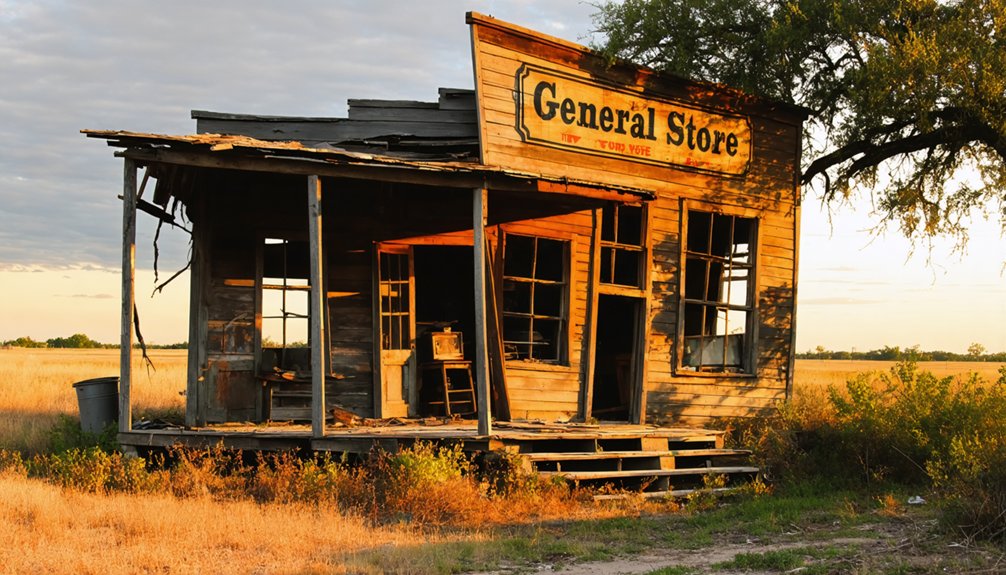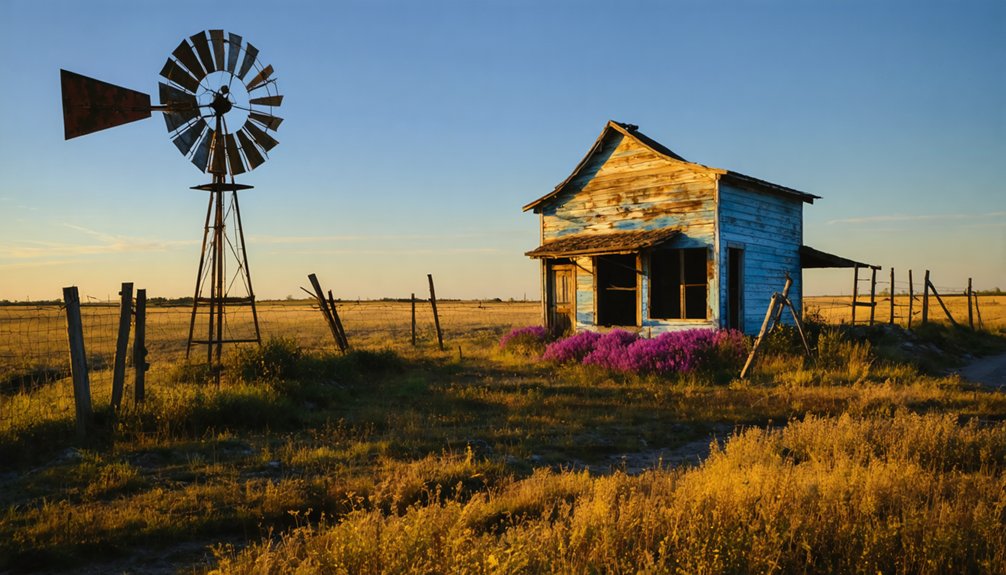You’ll find Mustang Prairie six miles northeast of Bremond, Texas – a ghost town with roots in Sterling Robertson’s 1834 land grant. After the Civil War, settlers from Alabama, Tennessee, and Mississippi built farms and established the New Hope Baptist Church in 1872. The railroad’s arrival in 1870 brought brief prosperity, but by the 2000s, only 50 residents remained. Today, empty lots and a cemetery tell a story that’s deeper than its quiet surface suggests.
Key Takeaways
- Mustang Prairie became a ghost town by 2006 with only 50 residents remaining, lacking basic utilities like water and electricity.
- Located six miles northeast of Bremond, the town initially thrived after the 1870 railroad arrival but declined significantly post-2000s.
- The community’s demise accelerated after a 2008 murder at Wispers Cabaret, leaving behind empty lots and demolished buildings.
- Only a cemetery and historical marker remain today, with poor road access isolating the former settlement from urban areas.
- Businessman Mark Cuban purchased the ghost town in 2021, marking the latest chapter in Mustang Prairie’s history.
Origins in the Robertson Land Grant
While Texas was still under Mexican rule, the Texas Association formed in Nashville, Tennessee on March 2, 1822, with 70 prominent members including Dr. Felix Robertson, Sam Houston, and Sterling C. Robertson.
They’d set their sights on establishing a colony in Texas, investing $4,000 to petition Mexico for settlement rights.
Under Robertson’s leadership, the colony faced numerous challenges. After Robert Leftwich secured the initial grant in 1825, covering 17 present-day Texas counties, the project stalled due to Mexico’s changing colonization laws. The colony was initially dubbed Leftwich’s Grant per the terms of the contract sale.
You’ll find that land disputes soon emerged between Robertson and Stephen F. Austin, who contested the territory. The Law of April 6, 1830 halted further American immigration into Texas, creating additional obstacles for the colony. Despite these setbacks, Robertson persevered, gaining empresario rights in 1834.
He appointed William H. Steele to issue land titles, though conflicting claims would plague settlers for years to come.
Early Settlement and Growth
You’ll find Mustang Prairie’s humble beginnings tied directly to the Robertson Land Grant, where only a sparse population of settlers made their homes before the Civil War.
These early residents, mostly from Alabama, Tennessee, and Mississippi, established themselves in the remote area between what would later become Kosse and Bremond, Texas.
The community’s real growth kicked off after the Civil War when the railroad reached nearby Bremond in 1870, bringing new business opportunities and settlers to the area.
The area experienced significant development during the Reconstruction era, which brought more families seeking new opportunities.
The Houston & Texas Central Railroad transformed the region, making it easier for farmers to transport their goods and encouraging further settlement.
Land Grant Origins
After Texas gained independence from Mexico, the Republic’s land grant system became the driving force behind Mustang Prairie’s early settlement.
You’ll find that most settlers received headrights of 640 acres for families or 320 acres for single men, while military veterans earned bounty grants ranging from 320 to 4,605 acres for their service in the Texas Revolution.
The land grant significance in Mustang Prairie’s development can’t be overstated. Settlers strategically chose plots along timbered creeks, drawn to the region’s rich black soil and abundant natural resources. The first land grants in the area began with Peter Fleming in 1825.
These settlement patterns formed around water sources despite flood risks, as early pioneers valued access to both water and wood. The grants created large, connected tracts that’d later shape the foundation of North Texas farming and ranching communities. The General Land Office was established to oversee the issuance of new land patents and maintain accurate records of all property transactions.
Post-Civil War Development
The land grant system laid the groundwork for what would become a thriving post-Civil War community in Mustang Prairie.
You’ll find that settler motivations were closely tied to the arrival of the railroad in nearby Bremond in 1870, which opened up tremendous economic opportunities in the region. Most newcomers made their way from Alabama, Tennessee, and Mississippi, seeking fresh starts in this promising Texas settlement.
Located six miles northeast of Bremond and three miles southwest of Kosse, Mustang Prairie’s strategic position made it attractive to business people and farmers alike. The area’s earliest roots trace back to trappers and hunters who established the initial settlement in the 1820s.
The railroad’s presence transformed this once-sparse settlement into a hub of activity, connecting residents to major markets and creating new possibilities for trade, agriculture, and commerce throughout Falls County. The establishment of New Hope Baptist Church in 1872 provided both religious services and early education before a dedicated schoolhouse was constructed.
Life on the Texas Prairie
Life on Texas prairies underwent dramatic changes as Native American traditions gave way to European settlement in the 19th century.
You’d hardly recognize the land your ancestors knew – where indigenous practices like controlled burns once maintained healthy prairie ecosystems supporting massive bison herds, you’d now find cotton fields stretching to the horizon.
The native peoples maintained a spiritual bond with the prairies, viewing nature as sacred family.
If you’d settled here in the late 1800s, you’d have joined German and Czech farmers breaking thick prairie sod with steel plows.
You’d have planted cotton as your cash crop, maybe some corn and wheat too.
By the late 1800s, 98% of prairies had been transformed into farmland.
Barbed wire would’ve changed everything about ranching – gone were the days of free-ranging cattle.
Instead, you’d have managed smaller pastures where overgrazing often led to degraded grasslands.
Life wasn’t easy, but settlers adapted to the harsh conditions, building communities around farming and ranching.
Notable Landmarks and Features
Standing sentinel along Falls County Road 283, Mustang Prairie Cemetery serves as the most prominent remaining landmark of this vanished Texas settlement.
You’ll find its historical marker providing context about the early settlers who came from Alabama, Tennessee, and Mississippi after the Civil War.
If you venture into the surrounding 75 acres of what was once Mustang Courts, you won’t see much of the town’s former life.
The old strip club, Wispers Cabaret, and a country western bar have been demolished.
Even the volunteer fire department’s dilapidated shed is gone.
The cemetery’s significance lies in its role as the last physical connection to this ghost town’s past, while scattered building foundations and footings are all that remain of the prairie community’s original structures.
The Path to Abandonment

After breaking away from Angus in July 1973, Mustang Prairie’s independence proved short-lived.
You’d have found a town that initially thrived on its liquor sales and adult entertainment, but economic challenges soon took their toll. By 2006, you’d see only about 50 residents remaining in this once-hopeful community.
The town’s lack of community resilience became apparent as businesses shuttered and buildings fell into disrepair.
A tragic 2008 murder at Wispers Cabaret dealt another blow to the area’s reputation, accelerating its decline. Without the ability to diversify beyond alcohol sales and surrounded by Angus’s stricter regulations, Mustang Prairie couldn’t sustain itself.
The demolition of key structures, including the strip club and fire department shed, marked the final chapter in this small town’s story.
Modern-Day Ghost Town Status
Today in Mustang Prairie, you’ll find nothing more than empty lots and demolished buildings where a community once stood. Mark Cuban’s ownership hasn’t changed the classic ghost town characteristics that define this remote Texas location.
With no running utilities, deteriorating infrastructure, and zero economic viability, it’s a stark reminder of how quickly towns can fade into obscurity.
Time strips away more than memories – empty streets and crumbling walls tell stories of prosperity turned to dust.
You’ll notice these defining features:
- No active population or functioning businesses
- Lack of basic services like water, electricity, or sewage
- Poor road access and isolation from urban areas
Despite some cleanup efforts, there’s no sign of revival on the horizon. The town’s future remains uncertain, with legal complexities and high maintenance costs deterring potential development.
It’s just another dot on the map of abandoned Texas communities, waiting for time to decide its fate.
Legacy in Texas History

You’ll find Mustang Prairie’s legacy preserved in early settlement records that detail the post-Civil War migration of southern families into this Texas farming community.
The town’s story captures the lost details of rural life, from agricultural endeavors to the close-knit social fabric that defined many small prairie settlements.
Through its cemetery markers and historical documentation, Mustang Prairie continues to serve as a cultural touchstone for understanding how these rural Texas communities shaped the state’s development after the Civil War.
Early Settlement Records Found
Through extensive historical records and land grant documents, researchers have traced Mustang Prairie’s origins to the Sterling Robertson land grant of 1834, marking the first legal settlement claims in the area.
You’ll find that settlement demographics shifted dramatically in the 1840s when Native American removal opened the region for pioneers from Alabama, Tennessee, and Mississippi.
- The New Hope Baptist Church, established by Jonathan B. Davis in 1872, served as both a spiritual center and the community’s first schoolhouse.
- Early education took shape in 1877 with a three-room schoolhouse, later expanding to eighth-grade education by 1910.
- Cemetery records from 1869, including Laura M. Jones’s tombstone, provide vital evidence of the earliest Anglo-American settlers.
The rich Trinity soil and natural springs drew these determined pioneers to establish their independent community along the creek banks.
Lost Rural Life Details
The rich tapestry of rural life in Mustang Prairie began to unravel in the decades following its early settlement period, leaving behind fragments of a once-thriving farming community.
You’ll find that the area’s rural traditions were deeply rooted in Southern agricultural practices, with families working small farms and tending livestock under Texas’s hot summers and mild winters.
The natural landscape, dotted with wild mustangs and grapes, shaped the community’s character.
But economic challenges took their toll – by the 2000s, you’d hardly recognize the place.
Where once stood gathering spots and family farms, you’ll now find only a cemetery and historical marker.
The community’s final chapter was marked by the closure of its last establishments, including a strip club and country western bar, completing its evolution to ghost town status.
Cultural Memory Preservation
While modern-day visitors might find little remaining of Mustang Prairie’s physical presence, its legacy lives on through careful preservation efforts and historical documentation.
You’ll discover how cultural narratives shape memory construction through various preservation methods that keep this piece of Texas history alive.
- The historical marker and cemetery serve as tangible links to the past, helping you connect with the settlement’s roots in the 1834 Sterling Robertson land grant.
- Census records reveal the cultural fabric of post-Civil War settlers from Alabama, Tennessee, and Mississippi.
- The Texas Historic Sites Atlas officially recognizes Mustang Prairie’s significance, ensuring future generations can trace their heritage.
These preservation efforts don’t just maintain records – they’re keeping the spirit of Texas freedom and independence alive through documented history.
Preservation and Historical Records

Despite ongoing efforts to document Mustang Prairie‘s history, preservation of this Texas ghost town remains minimal, with only a cemetery and historical marker surviving as physical remnants.
You’ll find that preservation challenges stem from limited archival records and the absence of standing structures, making it difficult to piece together the complete story of this post-Civil War settlement.
The historical significance of the area spans two distinct periods: the original Mustang Prairie settlement, established from the Sterling Robertson land grant of 1834, and the later incorporation of Mustang in 1973 for liquor sales.
While news archives and legal documents provide glimpses into the town’s controversial past, you won’t find many dedicated historical studies or archeological records.
Mark Cuban’s recent $2 million purchase in 2021 marks the latest chapter in this ghost town’s fragmented history.
Frequently Asked Questions
What Dangerous Wildlife Was Commonly Encountered by Early Mustang Prairie Settlers?
You’d face deadly snake encounters with rattlesnakes and cottonmouths, while predator threats came from coyotes, bobcats, and mountain lions. Fire ants, mosquitoes, and ticks made life tough too.
How Did Residents Get Their Drinking Water in Mustang Prairie?
You’d have relied on 17-foot wells for your water supply, though it was brackish and mineral-heavy. When wells dried up, you’d turn to cypress cisterns for collecting rainwater as backup.
Were There Any Famous Outlaws or Gunfights in Mustang Prairie?
You won’t find any documented outlaw legends or gunfight stories there. While Texas had its share of famous outlaws like Sam Bass and Hardin, they didn’t leave their mark in this particular spot.
What Did Children Do for Entertainment in Early Mustang Prairie?
You’d spend your days with playful pastimes like tag, swimming in creeks, horse riding, and childhood games. When evening came, you’d gather ’round for storytelling, church socials, and homemade entertainment.
Did Any Native American Tribes Live in the Mustang Prairie Area?
You’d find the Karankawa were your main tribe here, following seasonal patterns as they’d hunt bison and deer inland during warm months, then return to coastal areas for fishing in winter.
References
- https://www.businessinsider.com/mustang-mark-cuban-texas-ghost-town-empty-mysterious-2024-1
- https://www.texasstandard.org/stories/texas-population-boom-ghost-towns-rural-urban-suburban-shift/
- https://discovertexasoutdoors.com/places/mustang-prairie/
- https://en.wikipedia.org/wiki/List_of_ghost_towns_in_Texas
- http://www.txgenweb.org/research/landmarks/midland.htm
- https://atlas.thc.texas.gov/Details/5145011872
- https://www.ghosttowns.com/states/tx/mustangprarie.html
- https://www.texasescapes.com/CentralTexasTownsNorth/Mustang-Texas.htm
- https://www.texasalmanac.com/places/mustang-prairie-0
- https://www.glo.texas.gov/archive-collections/robertsons-colony-records



